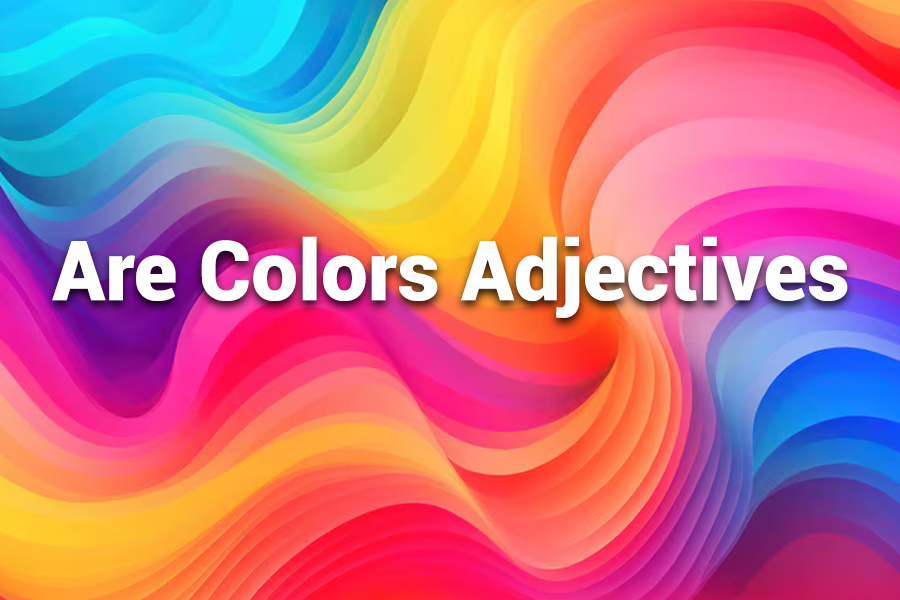Color words—red, blue, green—make everyday conversation vivid. Yet they often spark confusion about whether they act as adjectives or something else.
In this article you will learn exactly when colors function as adjectives, when they serve as nouns, and how to use them correctly in English. You will see clear rules, plenty of examples, and warnings about common mistakes.
What Are Adjectives?
Adjectives describe or modify nouns and pronouns. They answer questions like “Which one?” “What kind?” or “How many?” Color words often fill this descriptive role: “the red car,” “a blue house,” “her green eyes.” In those sentences, red, blue, and green modify nouns—so they behave as adjectives.
Color Words as Nouns vs. Adjectives
Color terms don’t stay fixed in function. They can appear as adjectives, nouns, or even verbs depending on context.
When used as adjectives, they directly describe something:
- “She wore a yellow dress.”
- “The grass looked greener this morning.”
When used as nouns, they name the color itself:
- “Yellow is her favorite.”
- “I like blue better than red.”
Sometimes a color noun functions in countable form, referring to a shade or example:
- “Do you carry this shirt in a red?”
- “He won a silver in the race.”
Thus, a color word may shift between grammatical roles depending on how you use it.
How to Recognize Color as Adjective
Here are key signals that a color word is acting as an adjective:
- It modifies another noun directly (placed before the noun): “bright red balloon.”
- It follows linking verbs like is, feels, looks: “The wall is green.”
- It appears in a comparative or superlative: “greener,” “reddest.”
If a color word does not modify something, it tends to act as a noun:
- “Green is calming.”
- “Her favorite shade is teal.”
When Color Words Work as Nouns
Color words become nouns when they refer to the idea or entity of the color itself, not modifying another noun.
Examples:
- “Red dominates this painting.”
- “I prefer dark purple to light.”
In some casual speech, a color can even refer to a physical object of that color:
- “Pick the red.” (meaning “the red one”)
But using that implies a shared context where “red” stands for a specific object.
Why Color Words Aren’t Always Adjectives
Not every color word is locked into the adjective category. Because language is flexible, many words shift parts of speech.
A classic example:
- Adjective use: “She bought a pink sweater.”
- Noun use: “Pink suits her well.”
In some cases, color words become verbs: “They color their drawings weekly.”
So the one word “color,” and related hue names, can move among noun, adjective, and verb roles.
Rules and Patterns to Watch
Here are reliable patterns for using color words well:
- Order doesn’t matter among colors: “white, red, blue flowers” is fine.
- When multiple adjectives appear, color typically comes after size or opinion, e.g. “nice big blue car.”
- Use “in + color” when you refer to wearing or being colored: “in red,” “in blue.”
Comparative Forms and Shades
You can compare colors: “bluer,” “more colorful,” “less bright.”
You can also modify color words themselves with degrees: “a very dark blue,” “light greenish-yellow.”
Common Mistakes to Avoid
- Don’t confuse noun use with adjective role: “I love blue” vs. “I love the blue car.”
- Avoid forcefully making countable nouns out of color unless context allows: “a red” only works in certain cases.
- Don’t stack colors as adjectives without clarity: “the red blue shirt” is confusing unless the object is multi-colored.
Examples That Illustrate Usage
- Adjective: “The red apple tastes delicious.”
- Predicate adjective: “That car is red.”
- Noun: “Red appeals to me.”
- Countable noun: “The team wears a red and white.”
- Mixed: “She painted the walls green and blue.”
Why This Distinction Matters
Understanding whether a color word is adjective or noun helps with correct sentence structure, subject-verb agreement, and proper phrasing when describing. Misusing them can make writing awkward or ambiguous.
Latest Observations and Usage Trends
In modern usage, we see color words increasingly treated flexibly—especially in branding, fashion, and design. Words like “navy,” “rose,” “maroon” move fluidly between noun and adjective roles. The rise of product descriptions has pushed color words to become adjectives in complex compounds (“navy-blue suit,” “rose gold finish”).
Conclusion
Yes, colors can be adjectives when they describe nouns. But in many cases, they function as nouns when they name the hue itself. Context and sentence structure determine which role they play. Recognizing that flexibility helps you use color words precisely and clearly in your writing.
